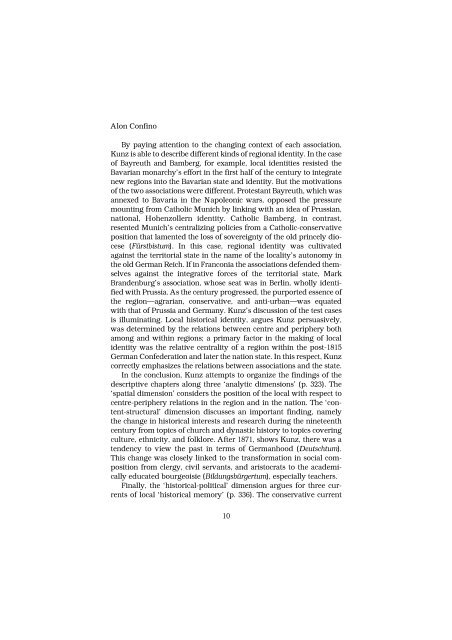Download - German Historical Institute London
Download - German Historical Institute London
Download - German Historical Institute London
Create successful ePaper yourself
Turn your PDF publications into a flip-book with our unique Google optimized e-Paper software.
Alon Confino<br />
By paying attention to the changing context of each association,<br />
Kunz is able to describe different kinds of regional identity. In the case<br />
of Bayreuth and Bamberg, for example, local identities resisted the<br />
Bavarian monarchy’s effort in the first half of the century to integrate<br />
new regions into the Bavarian state and identity. But the motivations<br />
of the two associations were different. Protestant Bayreuth, which was<br />
annexed to Bavaria in the Napoleonic wars, opposed the pressure<br />
mounting from Catholic Munich by linking with an idea of Prussian,<br />
national, Hohenzollern identity. Catholic Bamberg, in contrast,<br />
resented Munich’s centralizing policies from a Catholic-conservative<br />
position that lamented the loss of sovereignty of the old princely diocese<br />
(Fürstbistum). In this case, regional identity was cultivated<br />
against the territorial state in the name of the locality’s autonomy in<br />
the old <strong>German</strong> Reich. If in Franconia the associations defended themselves<br />
against the integrative forces of the territorial state, Mark<br />
Brandenburg’s association, whose seat was in Berlin, wholly identified<br />
with Prussia. As the century progressed, the purported essence of<br />
the region—agrarian, conservative, and anti-urban—was equated<br />
with that of Prussia and <strong>German</strong>y. Kunz’s discussion of the test cases<br />
is illuminating. Local historical identity, argues Kunz persuasively,<br />
was determined by the relations between centre and periphery both<br />
among and within regions; a primary factor in the making of local<br />
identity was the relative centrality of a region within the post-1815<br />
<strong>German</strong> Confederation and later the nation state. In this respect, Kunz<br />
correctly emphasizes the relations between associations and the state.<br />
In the conclusion, Kunz attempts to organize the findings of the<br />
descriptive chapters along three ‘analytic dimensions’ (p. 323). The<br />
‘spatial dimension’ considers the position of the local with respect to<br />
centre-periphery relations in the region and in the nation. The ‘content-structural’<br />
dimension discusses an important finding, namely<br />
the change in historical interests and research during the nineteenth<br />
century from topics of church and dynastic history to topics covering<br />
culture, ethnicity, and folklore. After 1871, shows Kunz, there was a<br />
tendency to view the past in terms of <strong>German</strong>hood (Deutschtum).<br />
This change was closely linked to the transformation in social composition<br />
from clergy, civil servants, and aristocrats to the academically<br />
educated bourgeoisie (Bildungsbürgertum), especially teachers.<br />
Finally, the ‘historical-political’ dimension argues for three currents<br />
of local ‘historical memory’ (p. 336). The conservative current<br />
10













